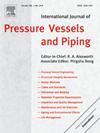Evolution of microstructure and crystallographic texture of high-frequency electric-resistance welded X65 pipeline steel
IF 3.5
2区 工程技术
Q2 ENGINEERING, MECHANICAL
International Journal of Pressure Vessels and Piping
Pub Date : 2025-07-19
DOI:10.1016/j.ijpvp.2025.105609
引用次数: 0
Abstract
The microstructure and texture evolution in X65 steel pipe high-frequency electric-resistance welding (HF-ERW) zones under as-welded and heat-treated conditions were investigated in this study. Dynamic recrystallization occurs in austenite within the bondline and coarse-grained heat-affected zone (CGHAZ), but in ferrite within the fine-grained heat-affected zone (FGHAZ). The CGHAZ exhibits higher residual stress than the FGHAZ. The thermomechanical-affected zone (TMAZ) exhibits only dynamic recovery and deformation. The grain orientations in the weld zone and matrix were similar under compressive stress direction (weld zone-TD, matrix-ND). Along TD, the bondline, CGHAZ and FGHAZ develop {111} recrystallization textures, whereas TMAZ forms {100}<011> and {111} deformation textures. After heat treatment, the weld zone retains the texture characteristics of the as-welded condition. Conventional heat treatment increases harmful <100>//TD and <110>//TD texture components in the CGHAZ, whereas optimized treatment reduces these components, enhances high-angle grain boundaries, and refines grains. These texture components originate from {110}<001>, {100}<011>, and {110}<110> orientations formed during welding thermo-mechanical processes. They intensify in the CGHAZ after conventional treatment due to residual stresses but weaken after optimized treatment through phase transformation effects. This provides valuable insights into texture development during welding.
X65管线钢高频电阻焊组织与晶构演变
研究了X65钢管高频电阻焊(HF-ERW)区在焊接状态和热处理条件下的组织和织构演变。动态再结晶发生在结合线上和粗晶热影响区内的奥氏体中,而发生在细晶热影响区内的铁素体中。ghaz的残余应力高于fhaz。热-机械影响区(TMAZ)仅表现为动态恢复和变形。在压应力方向(焊缝区- td,基体- nd)下,焊缝区和基体的晶粒取向相似。沿TD方向,ggaz和fgaz形成{111}再结晶织构,而TMAZ形成{100}<;011>;和{111}变形纹理。热处理后,焊缝区保持了焊接状态的织构特征。常规热处理增加了chaz中有害的<;100>;//TD和<;110>;//TD织构成分,而优化热处理减少了这些成分,增强了高角度晶界,细化了晶粒。这些纹理组件来源于{110}<;001>;、{100}<011>;和{110}<;110>;焊接热机械过程中形成的取向。它们在常规处理后由于残余应力而在chaz中增强,而在优化处理后由于相变效应而减弱。这为焊接过程中的织构发展提供了有价值的见解。
本文章由计算机程序翻译,如有差异,请以英文原文为准。
求助全文
约1分钟内获得全文
求助全文
来源期刊
CiteScore
5.30
自引率
13.30%
发文量
208
审稿时长
17 months
期刊介绍:
Pressure vessel engineering technology is of importance in many branches of industry. This journal publishes the latest research results and related information on all its associated aspects, with particular emphasis on the structural integrity assessment, maintenance and life extension of pressurised process engineering plants.
The anticipated coverage of the International Journal of Pressure Vessels and Piping ranges from simple mass-produced pressure vessels to large custom-built vessels and tanks. Pressure vessels technology is a developing field, and contributions on the following topics will therefore be welcome:
• Pressure vessel engineering
• Structural integrity assessment
• Design methods
• Codes and standards
• Fabrication and welding
• Materials properties requirements
• Inspection and quality management
• Maintenance and life extension
• Ageing and environmental effects
• Life management
Of particular importance are papers covering aspects of significant practical application which could lead to major improvements in economy, reliability and useful life. While most accepted papers represent the results of original applied research, critical reviews of topical interest by world-leading experts will also appear from time to time.
International Journal of Pressure Vessels and Piping is indispensable reading for engineering professionals involved in the energy, petrochemicals, process plant, transport, aerospace and related industries; for manufacturers of pressure vessels and ancillary equipment; and for academics pursuing research in these areas.

 求助内容:
求助内容: 应助结果提醒方式:
应助结果提醒方式:


